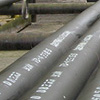

Hunan Standard Steel as a member of Husteel Industry Group, is a professional manufacturer of mild steel pipes and pipe fittings, which has a complete system of production... More
Factory GroupCorrosion of Alloy Tube
Date:2016-11-02
Views:2260
Before the jet treatment, the grease and fouling of the surface of the alloy pipe are removed, and the pipe body can be preheated to 40-60 degrees celsius by a heating furnace to keep the surface of the alloy pipe dry, the original degree of corrosion, the required surface roughness degree, the type of coating to choose abrasive, single-layer epoxy, two or three polyethylene coating, in order to achieve the desired effect of rust, alloy steel tube and steel shot need to use mixed abrasive. Because the steel shot has the effect of strengthening the steel surface, steel sand has the role of etching the steel surface.
Alloy tube want to get better uniformity of cleanliness and roughness of the distribution, the abrasive particle size and proportion design is very important,because the roughness is too easy to cause corrosion in the anchor thinning at the peak, At the same time, because the anchor pattern is too deep, it is easy to form bubbles in the process of corrosion, a serious impact on the performance of the coating. Because the alloy pipe surface is free of grease and other dirt, which can enhance the effect of rust, in addition, the dry alloy pipe surface is also conducive to steel shot, grit and rust and oxide skin separation, Rust after the alloy tube surface is more clean.
Alloy tube before plating stress and after the hydrogen plating to eliminate hydrogen embrittlement if the parts by quenching, welding and other processes after the internal residual stress larger, should be tempered before plating, tempering to eliminate stress can actually reduce the parts of the The number of traps, alloy tubes to reduce the risk of occurrence of hydrogen embrittlement. Therefore, hardness <32HRC of the fasteners, alloy tube coating thickness can be required in 12μm; hardness ≥ 32HRC high-strength bolts, coating thickness should be controlled at 8μmmax. This requires product design, we must take into account the high-strength bolts of hydrogen embrittlement risk, a reasonable choice coating species.
Alloy tube want to get better uniformity of cleanliness and roughness of the distribution, the abrasive particle size and proportion design is very important,because the roughness is too easy to cause corrosion in the anchor thinning at the peak, At the same time, because the anchor pattern is too deep, it is easy to form bubbles in the process of corrosion, a serious impact on the performance of the coating. Because the alloy pipe surface is free of grease and other dirt, which can enhance the effect of rust, in addition, the dry alloy pipe surface is also conducive to steel shot, grit and rust and oxide skin separation, Rust after the alloy tube surface is more clean.
Alloy tube before plating stress and after the hydrogen plating to eliminate hydrogen embrittlement if the parts by quenching, welding and other processes after the internal residual stress larger, should be tempered before plating, tempering to eliminate stress can actually reduce the parts of the The number of traps, alloy tubes to reduce the risk of occurrence of hydrogen embrittlement. Therefore, hardness <32HRC of the fasteners, alloy tube coating thickness can be required in 12μm; hardness ≥ 32HRC high-strength bolts, coating thickness should be controlled at 8μmmax. This requires product design, we must take into account the high-strength bolts of hydrogen embrittlement risk, a reasonable choice coating species.





















